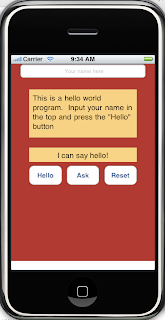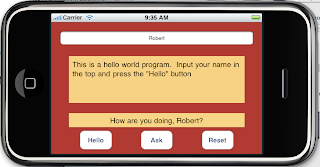
I finished the iPhone tutorial for the second time yesterday. I completed it as the first thing that I wanted to do, just to learn how to get code setup on the iPod touch, and then went to reading documentation. After doing a lot of reading, going back and doing the first tutorial again helped significantly. The first run was making sure I could get the example working, while the second immersion was to explore the different concepts more in-depth. Reading the Objective-C language documentation last night clarified many of the language concepts from the tutorial.
Context helps language learning significantly, especially if you do immerse yourself if the language and don't worry about exactly what it is doing. The important issue is that you understand the general concepts of what is going on. Just as is everyday human languages, you may not be able to represent the same concept using a one-to-one correspondence of smaller components. There may be some building blocks (cases of words, loop structures, etc.) which don't exist in the other language.
Reading the language and actually working to produce a step-by-step example provide a quick method to develop your intuition about the language. Proceeding without any preconceptions of how things are done is what allows children to develop language skills quickly. Thinking in the other language, rather than translating, provides the additional benefit of allowing you to develop new patterns of thinking that are orthogonal to how you do things currently, since it hides your normal way of doing things.
The second time I did the iPhone/iPod touch example, I added additional functionality on top of that provided in the tutorial. I added a button to change the label text to "How are you doing, [name]?" instead of just the provided "Hello, [name]." Also, I added a button to reset the name to placeholder text, and the label to the starting text, "I can say hello!". This predefined environment allows for exploration and play than starting from scratch. "I broke it by doing this, so I'll revert my changes and try something else." The Agile concept of always having a running demo helps us learn languages more quickly and more thoroughly through experimentation.
As seen in the images here, I added an uneditable text view showing the purpose of the program. Also, the "Reset", and "Ask" buttons are new from the tutorial, as is the support for horizontal, "landscape", mode was added. Not an award winning program, but I am proud of being able to extend the functionality of the original program and add some features I wanted. The learning experience was invaluable, but it is still only an initial step toward developing iPhone/iPod Touch applications.

No comments:
Post a Comment